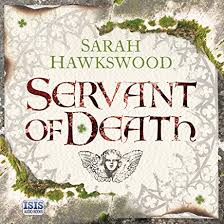My rating: 4 of 5 stars ⭐⭐⭐⭐
Duration: 8 hrs 11 mins.
Publisher: Isis Publishing Ltd.
Servant of Death, Bradecote and Catchpoll, Book 1 by Sarah Hawkswood is an immersive 12th Century murder mystery, and the first adventure for mediaeval men-of-law, Bradecote and Catchpoll.
Audible Summary: "The much-feared and hated Eudo - the Lord Bishop of Winchester's clerk - is bludgeoned to death in Pershore Abbey and laid before the altar in the attitude of a penitent. Everyone who had contact with him had reason to dislike him, but who had reason to kill him?
The Sheriff of Worcestershire's thief taker, wily Serjeant Catchpoll, and his new and unwanted superior, Undersheriff Hugh Bradecote, have to find the answer. And as the claustrophobic walls of the abbey close in on the suspects, the killer strikes again....
©2014 Sarah Hawkswood (P)2017 Isis Publishing Ltd."
The Sheriff of Worcestershire's thief taker, wily Serjeant Catchpoll, and his new and unwanted superior, Undersheriff Hugh Bradecote, have to find the answer. And as the claustrophobic walls of the abbey close in on the suspects, the killer strikes again....
©2014 Sarah Hawkswood (P)2017 Isis Publishing Ltd."
Unless you count various re-tellings of Robin Hood, Blackadder, and dozens of episodes of Time Team, then I cannot claim to have any great insight into the mediaeval era in which this series is set. I've neither studied it in any detail nor read it very widely, so it was comforting to know that I was in the hands of a historian who could be trusted to deliver enough authenticity to really bring this fictional mystery to life.
As anticipated, there is a great deal of historical detail in this audiobook, all woven into the backdrop upon which the story plays out. It is not overwhelming, but provides the listener with enough information to understand the cultural and political temperature of the time, especially as it shifted so greatly, and with such frequency.
I loved the wealth of almost throwaway period detail, like "the inks gave fantastic colours to the flames" when Master Elias was burning documents. There were two main kinds of inks in use at the time; carbon-based inks, and oak-gall inks, with each formulation containing components that react differently to heat. Ferrous sulphate, as commonly found in the black gall inks, often produces an orange flame when burned, whereas if copper salts were used instead of iron the flame would be blue or green. The mercuric sulphide found in the corrective red ink of the era (for which I have a particular fondness) may burn equally red, with the unadulterated parchment and lamp-black inks displaying standard orangey-yellow hues.
I used to own a fascinating little book on the history and preparation of inks, bought in the late 90s when I took up calligraphy, but this video from the Getty Museum gives a brief overview of the ingredients used for illuminated documents, in The Alchemy of Color and Chemical Change in Medieval Manuscripts.
Due to the introduction of so many characters at the start, it took until I was almost halfway through this audiobook to really feel as though I was beginning to know Bradecote and Catchpoll, and from then it picked up some pace and was more engaging. It is rare for the first book in a series not to have slow spots, and there was enough colour in Hawkswood's mediaeval world to hold my interest until the characters could do so in their own right.
The author's decision to have the less experienced officer in the superior position allowed for a more nuanced dynamic than the traditional 'seasoned cop takes on a rookie' plot we see so often in popular fiction. I liked the light and shade each investigator brings to the story, and appreciated the fact that they were not cookie-cutter Holmes and Watson stereotypes, with the less-glamorous Catchpoll often being one step ahead of the younger and more learned Bradecote. Though Catchpoll does not have Bradecote's standing or education, Bradecote's experience pales beside Catchpoll's expert efficiency. Where one is rough, the other is smooth - in many aspects - and yet they still feel similar, for their occupation is underpinned by complementary values. This is a formula well known to crime writers, but it is nicely done here and the trope's familiarity helps anchor the investigation in the listener's mind; however alien the medieval landscape may be, the intrepid duo's pursuit of justice spans centuries.
The insight into Bradecote's relationship with his wife was interesting, for we usually only hear of similar dissatisfaction - arising from ill-matched intellect - from the female perspective. Men in historical fiction are seldom perturbed by a simple wife, providing she remains eager to please, or at least compliant enough to produce an heir. Bradecote's unease at the transactional nature of their union, despite the marriage fulfilling its reproductive obligations, helps make him more relatable to a modern audience. Although Bradecote is no rogue, neither is he without flaw or immune from sin, and that makes him far more real.
The impenetrable confusion exhibited by most of the novel's males when dealing with calm and competent women was amusing. Even today there is a prevailing expectation of some hysteria when women are involved in a crisis, and I enjoyed the Under-Sherriff's discomfort when interviewing women like Mistress Weaver and Sister Edeva, who did not conform to his, or the Serjeant's, preconceptions of delicate feminine sensibility. In the same vein, it was also heartening that the most powerfully-intriguing woman was not the most charming or the most beautiful, but she who possessed the stronger and more intricate mind. Of all the supporting characters in Servant of Death, it is Sister Edeva whom I would be most keen to see return.
I smiled, too, at the little linguistic amusements which laid in wait to reward the attentive listener, such as a momentary flirtation of sorts which concludes with a blushing nun advising her companion, in all sincerity, that it is "almost time for sext".
Unlike the 18th and 19th Century historical fiction I have reviewed in depth elsewhere, mediaeval language is not as easy to replicate in full, nor is it especially desirable to try. So different is it to our modern usage that it would be too archaic for a novel, and the authenticity comes instead from the names and descriptions, which allow for the use of period terminology within a more contemporary grammatical structure. This helped the era remain accessible, without watering it down un-recognisably. The inclusion of surviving historical landmarks such as the imposing Pershore Abbey helped, too, with photos of its South Transept still bearing the scars of the buildings which were recreated in the novel.
The mystery itself felt rather bitty at times, but I think much of that is because there were so many characters to get to know that the tension and intrigue were sometimes lost within the individual reminiscences. This could have been trimmed a little, with less time given to describing already-deceased husbands in quite so much detail. Despite this, I enjoyed Bradecote and Catchpoll's inaugural outing, and am very much looking forward to continuing the series, thanks in equal part to the efforts of both author and narrator.
The narrator was a large part of my decision to begin Servant of Death this week, for after listening to the marvellous Alex Wyndham reading Noble Satyr this week, I knew he was going to be a tough act to follow. Who else could I turn to with any confidence, but Matt Addis? Once again I was impressed by Addis' performance, and not least for how natural he made many of the mediaeval pronunciations seem. He always has such a deft understanding of pace, never racing through scenes or letting them drag, and ensuring the listener remains fully engaged along the way.
Addis' talent for making the characters feel not only tangible but recognisable presents this unfamiliar landscape and its people as though we could be within touching distance of their time. In fact, his Hugh Bradecote reminded me a little of John Nettles, though whether as Bergerac or Barnaby I couldn't quite decide.
Addis always has a good range of character voices to call on; for all ages, classes, and genders. I only realised quite how diverse a cast he weaves in this audiobook when deliberately pondering the question for this part of the review! It is not that his performance is unworthy of note - far from it - but more that it flows so nicely I could listen without being aware that he was 'performing'. Whether portraying the gentlemanly Under-Sherriff, unpretentious Serjeant, or a cunning femme fatale, Addis' voices never feel put-on in the way that so often blights others' narration. Each character is imbued with a personality that feels true to the text, without distracting one's attention from the plot.
I would recommend this book to anyone who enjoys historical fiction, and most especially mysteries of Cadfael's ilk. It is likely to hold particular appeal for anyone who enjoys period novels that offer a broad glimpse into life at the time, with the women's situations explored in no less depth than the men's.
*I received this audiobook from the publisher free of charge in the hope of an honest, unbiased review.
(Click here to buy this book, listen to a sample, or add it to your wishlist!)













No comments